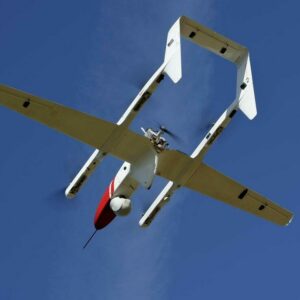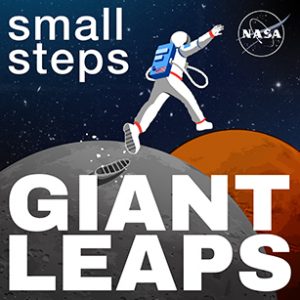Fighting wildland fires by air at night is especially hazardous. NASA’s ACERO Project aims to make firefighting safer – day or night – with drones and smarter airspace management.
As wildland fires grow more intense and unpredictable, NASA is helping first responders gain the upper hand. In this episode, we explore the ACERO Project, the team developing an airspace management system to enable drones and other aircraft to safely monitor and suppress wildland fires 24 hours a day. The system will increase aerial response capabilities for responders during low-visibility conditions in a way that is not currently possible. Firefighters in California are already using this technology. We speak with Patrick Hill, chief of uncrewed aircraft systems training at NASA’s Langley Research Center in Virginia.
In this episode, you’ll learn about:
- The technology used in ACERO
- The advantages of unpiloted aircraft
- A new Portable Airspace Management System developed by NASA

Credit: Patrick Hill
Patrick Hill serves as Chief of Uncrewed Aircraft Training at NASA’s Langley Research Center in Hampton, Virginia, where he leverages over a decade of uncrewed aircraft systems (UAS) expertise that began during his tenure at Embry-Riddle Aeronautical University. His operational proficiency spans a comprehensive range of platforms, from compact multirotor systems to large-scale fixed-wing aircraft and various configurations across the spectrum. In his role supporting the ACERO project, Patrick contributed essential expertise in risk assessment and flight operations planning while serving as Pilot in Command for the SuperVolo aircraft, demonstrating his technical leadership in both strategic planning and operational execution.
Resources
ACERO Project page
NASA’s Airspace Operations and Safety page
NASA Aeronautics
APPEL Courses
Introduction to Software Engineering
Applying Risk Management: From Theory to Practice
Transcript
Andres Almeida (Host): As wildland fires grow more intense and unpredictable, NASA is helping first responders gain the upper hand. We’re exploring ACERO, the Advanced Capabilities for Emergency Response Operations Project. It’s something that will better protect communities, potentially saving lives. This is Small Steps, Giant Leaps.
[Intro music]
Welcome to Small Steps, Giant Leaps, your podcast from NASA’s Academy of Program/Project & Engineering Leadership, or APPEL. Each episode dives into the lessons learned and experiences from NASA’s technical workforce.
Today we’re talking about ACERO and the team developing an airspace management system to enable drones and other aircraft to safely monitor and suppress wildland fires 24 hours a day. The system will increase aerial response capabilities for responders during low-visibility conditions in a way that is not currently possible. This will better protect our communities. Here to tell us about it is Patrick Hill, chief of Unmanned Aircraft Systems training at NASA’s Langley Research Center in Hampton, Virginia.
Host: Hey, Patrick, thanks for being here.
Patrick Hill: Yeah, thanks for having me.
Host: Can you talk a bit about ACERO, what it is and what is your role with the project?
Hill: Okay, yeah, so I’m a systems engineer and the chief of UAS training at NASA Langley Research Center. Before the flight demonstration, I was involved in payload testing and flight training. We were verifying the functionality all the individual parts that will go into the larger systems that we were testing during the flight demonstration. I was the acting pilot in command for the SuperVolo UAS. The SuperVolo is a hybrid electric, gas, electric, uncrewed aircraft system which takes off vertically and transitions to forward flight. These things combined allow the vehicle to quickly be deployed in some austere environments, while enabling it to stay in the air for much longer than other aircraft.
I would also like to mention that it wasn’t just me working on the project. We had dozens of individuals, from software developers to hardware integrators to systems engineers, airspace and ground crews, who all came together, put a lot of hours to accomplish the goals of the project.
Host: Yeah, that’s how it often is. It’s such an integrated process, right?
Hill: Yeah, it’s not just me out there. I know I’m a pilot, but, and we have high egos, but it’s a, it was not definitely just not me out there.
Host: So, can you tell us some advantages of using drones in wildland fire scenarios?
Hill: Sure. Let me start by laying out how things are currently done today. So UAS, or drones, are currently used for aerial ignition, where they would drop small pods, which ignite on the ground and start control burns. This manages the larger burns. In some scenarios, you’ll also have aerial ignition from crude aircraft. In the more severe wildfires, you’ll have crude aircraft coming in and dropping in tons of water or fire retardant. All of these aircraft are usually guided by an air boss who acts as a type of local airspace manager.
An important note is that during most of the burns today, when crewed aircraft are flying, the drones are not and then when the drones are flying, the crewed aircraft are not. Now, I’m not saying that we’re trying to completely replace all the crewed aircraft. That’s not what we’re trying to do here. What the drones are great at is dull, dirty, and dangerous jobs. We don’t really relate to wildfires as dull, but there are times where we can orbit our aircraft above a mountain for hours so ground crews could have a constant radio communication with each other.
UAS are also utilized to monitor critical information like local weather or the progression of the fire in real time. In the future, we plan on utilizing our systems in a second shift capability, or at night when the crewed aircraft are grounded. Low-flying aircraft around mountains at night don’t really jive together, and that’s a place where the UAS would really strive.
Host: What types of sensors and technologies are equipped to aid in wildland fire management?
Hill: So, for the ACERO flight demonstration, the aircraft I was operating was equipped with the Doodle Labs radio, which acted as a key node in a mesh network of ground radios operated out of these PAM cases we were testing. We also utilize our multirotor aircraft to monitor local weather in real time, equipping an aircraft with a radiosonde, which is the same payload that you would see on a weather balloon (while other crews were flying UAS, utilizing cameras to monitor the progression of the burn).
Host: I’d love to talk about the PAMS that you have. Can you talk about the Portable Airspace Management System?
Hill: Sure. So, the Portable Airspace Management Systems, or PAMS cases, because we love our acronyms here at NASA, is essentially a situational awareness gold mine for UAS and wildfire crews.
It allows crews to preserve a block of airspace to operate in during the flight demonstration, when given the green light from our airspace approver, who in this case, was performed by individuals from CAL FIRE the UAS crews were able to see all active flights. Crews were also notified of an aircraft if it was going non-conforming or straight outside of its pre-approved flight area. The case has also received ADS-B [Automatic Dependent Surveillance-Broadcast] in, which allows crews to monitor the local manned traffic in the area.
Host: So, you mentioned CAL FIRE. What has been the response to ACERO from emergency officials?
Hill: So, I don’t claim to be an emergency official myself, but from the individuals that we worked with during the ACERO flight demonstration, they all seemed extremely pleased with the products that we were able to produce.
I believe the PAMS case and the possibility of the future integration with the wildfire crews, both on the ground and in the air, was particularly seen as a useful technology that will generate forward momentum and integration of UAS in the wildfire and wildfire fighting airspace.
Host: So, looking ahead, what advancements Do you foresee in drone technology that could further aid in wildfire management.
Hill: Yeah, so first we need to be able to assist with controlling the airspace that you’re flying in, which is why we’re testing these PAMS cases.
As technology develops and we get more confidence in our systems, we would see a sharing of the airspace with the crewed side, having small UAS delivering equipment to crews in the field, while larger manned aircraft are able to come in and drop their water on location scouted by a UAS, which is flying at a high altitude, which may also be providing key nodes to radios and all crews on the ground.
And then going back to the second shift capabilities, [it] will allow crews to be constantly monitored and evolving fire or even react to it when it may not be possible to do otherwise.
Host: Do you find yourselves sharing knowledge across teams? Is that a core component of what you all do?
Hill: Yeah, so sharing the knowledge that we receive is part of NASA mission, right? So, everything that we’re doing should be passed forward to the public, which include includes the firefighter crews and their teams that are, you know, currently in these environments, working and fighting these fires.
Host: I do like learning from you the term Air Boss. I hadn’t heard that before, so that’s a term that’s wildfire management, correct?
Hill: Yeah, that’s correct. So, the Air Boss kind of acts as a flying ATC tower, right? And he gives out all the instructions to the aircraft coming in and out of what would actually be a TFR, or flight restricted area. And that would allow the, you know, continuation of all the aircraft going in and out at the low distances that these aircraft need to be at.
Host: With UAS, with these drones, you’re looking to complement, especially at night, right, when it’s less safe to fly, when it’s less safe for a pilot to fly.
Hill: Yeah, so, as it is today, for the most part, we ground all manned aircraft at night because, you know, there’s no lights on the mountains, and we don’t want these aircraft get flying into a dangerous area. Now, we do have aircraft that have terrain following and things like that, but the UAS are, in a lack of a better term, much more replaceable than a manned aircraft.
Host: Can you share any lessons learned from ACERO so far?
Hill: far? Well, California has some of the best burritos I’ve ever eaten! But seriously, we have learned a lot of great takeaways from our flight demonstration. In particular, we learned a lot about the complex integration of flying multiple UAS in a confined airspace, and what it takes to really do that safely.
A major takeaway that I received was that the communication line from the aircraft to the ground systems to everybody else is vital for all crews. It’s not just vital for our crew flying the aircraft, but for the other crews that are in the area need to know what’s going on with us as well.
Host: Patrick, one more question for you. What was your giant leap?
Hill: Yeah. So, my giant leap started way back when I was in college. My intent was to go to school and become an airline pilot. The way my major worked, I was able to take some classes studying UAS, and I was immediately sucked. In my second year of school, I took my giant leap, stepping away from my original major to study UAS, and I’ve never looked back. That decision has taken me places that I’d never have gone otherwise, like working for NASA.
Host: Do you think when you like your own, like pilot’s license just for recreation?
Hill: Yeah, so I actually have 70 hours in a crude aircraft, which is a stone’s throw away. I should probably have my license already, to be honest.
[Laughter]
But just the way things have worked, and I’ve got I’ve gained those hours in very short bursts many times. So, I reached the point to take my test several times and then gone back to restudy. But yes, I think one day in my future, I will be flying myself.
Host: There have to be many pilots there at Langley, correct? Like, recreational?
Hill: Yeah, yeah. So I think most of the people I work with have their own license or in some like, shape or form. We have a lot of glider pilots here, actually, which is, you know, that’s not something you see every day or run into, so, quite unique for the people that we have. But their skills are some of the best I’ve ever seen.
Host: That’s pretty great. Do you have any closing words for anybody who wants to pursue a career at NASA and something you’d follow in your footsteps, perhaps?
Hill: Follow your heart, but do what you’re good at? I loved UAS, and fortunately, I had an engineering mindset, which has taken me far in this in this world. So, if you’re, you know, planning on following my footsteps, go to school, get your degree, I bet you relied on mentors too, yeah, oh, yeah, so I wouldn’t have gotten where I am today without the help of, you know, former classmates, teachers, professors, my old bosses, my current bosses. Everybody has, you know, put a little bit of effort into the person I am today, which, you know, working for NASA is pretty fantastic.
Host: Well, thanks, Patrick, thanks for your time today.
Hill: Yeah, thanks. I really appreciate it. And also, as of this recording date, yesterday was Father’s Day. So, shout out to all the dads out there, especially my dad and my two brothers who recently had kids. Just want to put that out there.
Host: Excellent. Happy Father’s Day to all.
Host: That’s it for this episode of Small Steps, Giant Leaps. For more on Patrick Hill and the topics we discussed today, visit appel.nasa.gov. That’s A-P-P-E-L dot NASA dot gov. And while you’re there, check out our other podcasts like Houston, We Have a Podcast, Curious Universe, and Universo curioso de la NASA. Thanks for listening.
[Outro music]
Outro: Three. Two. One. This is an official NASA podcast.







